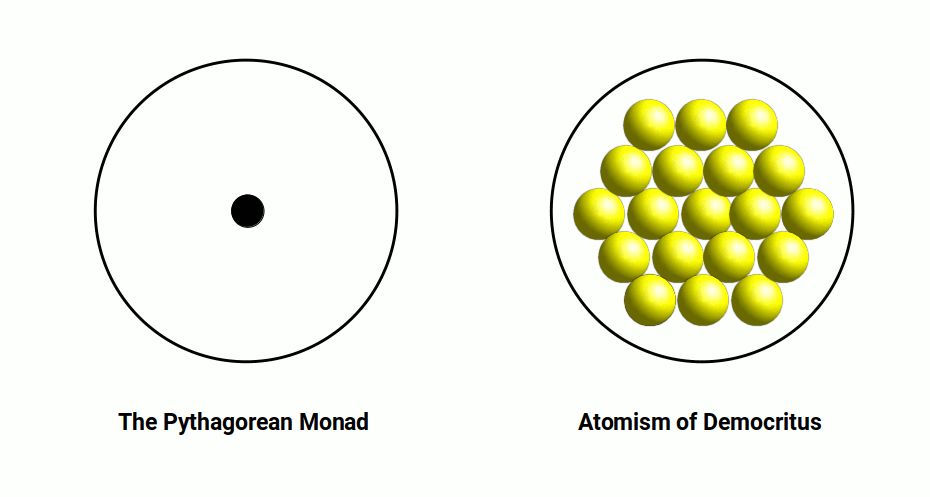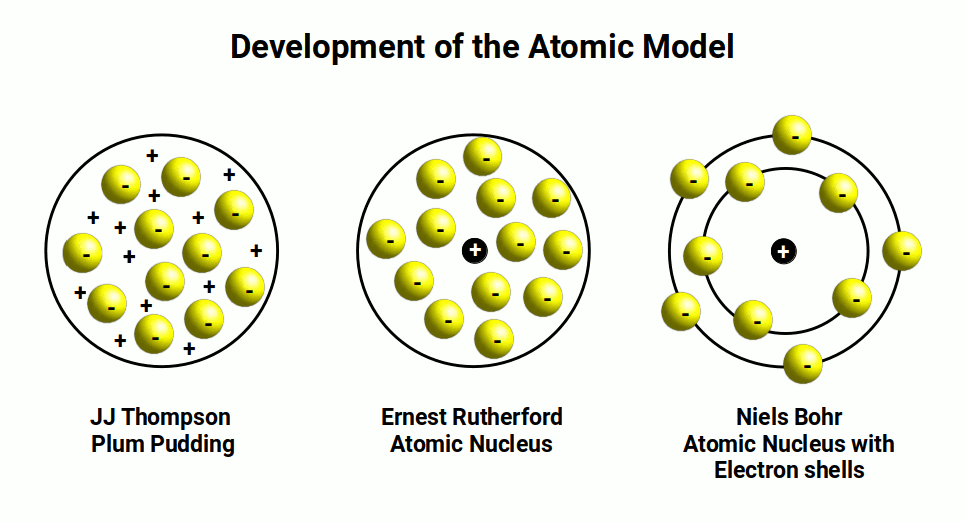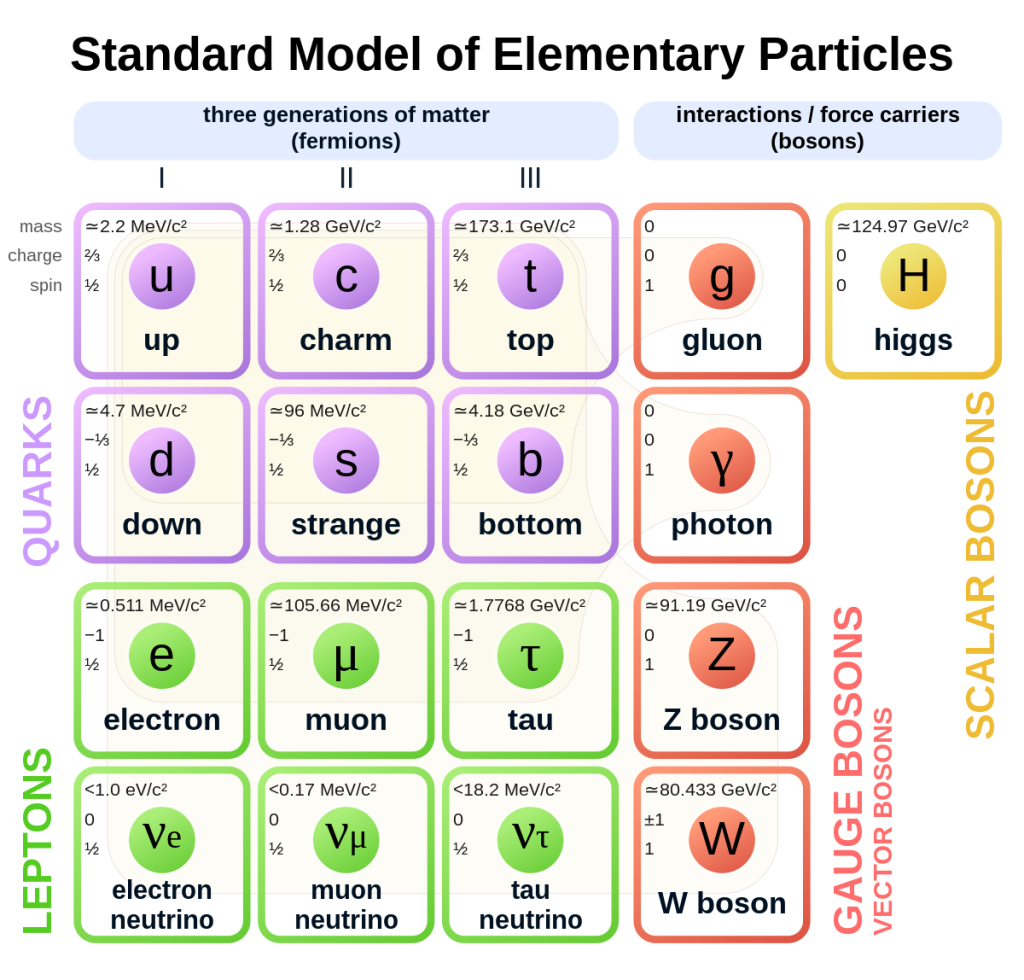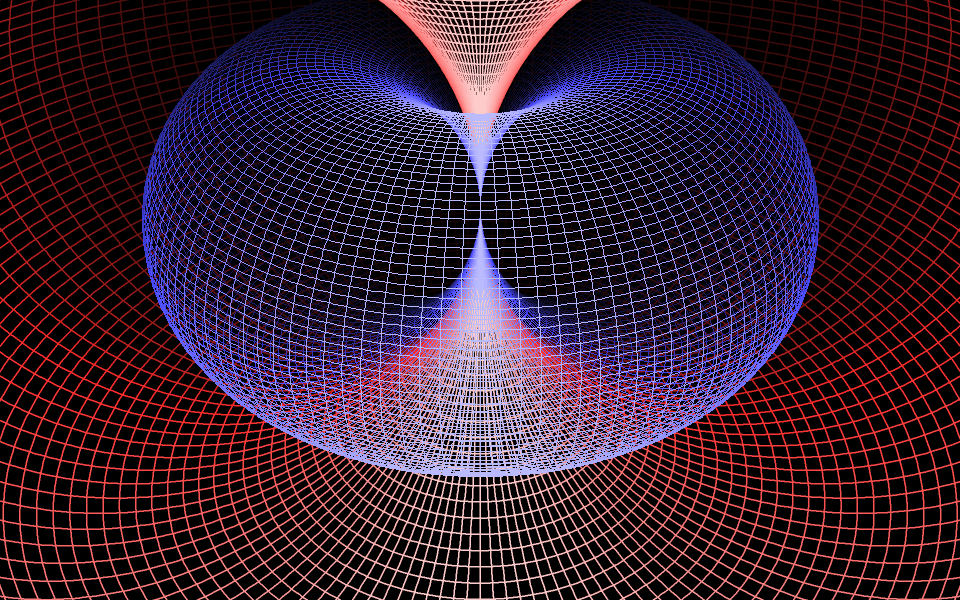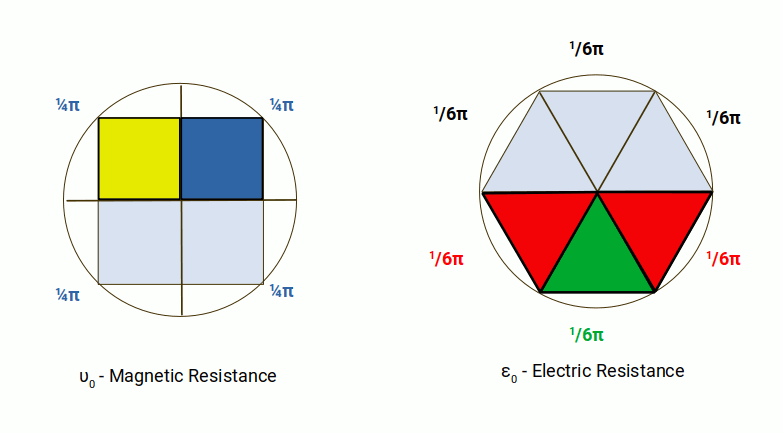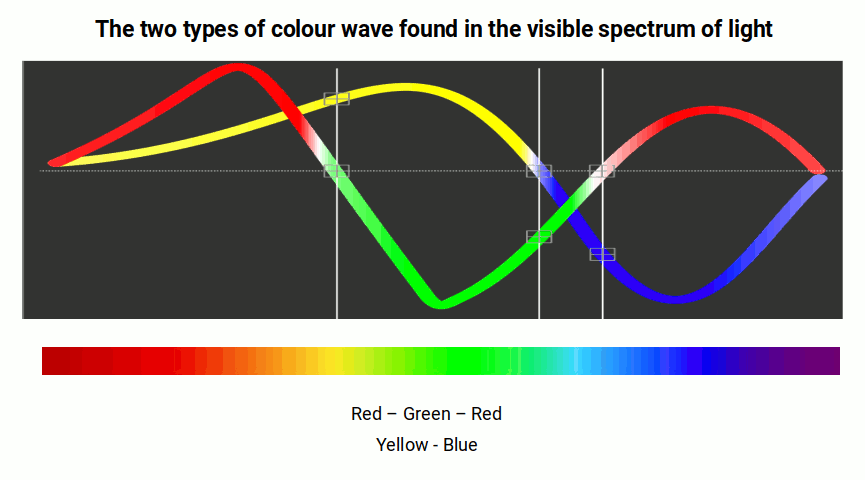
Just as the wave-particle model of light started to be established, it was suddenly discovered that matter also behaves similarly. When electrons were shone through a thin slit, the result produced an interference pattern. The idea that matter is a wave rapidly became accepted, giving birth to the electron cloud and quantum field. But the idea that matter existed as tiny particle points remains to this day the most popular interpretation of the atom. Yet, what happens if we consider matter from the perspective of the 4D Aether?
Overview
The notion of wave-particle duality of light was first established by Albert Einstein as a solution to the photoelectric effect. However, After this, it was discovered that matter also exhibits wave-like properties. Thus, the concept of wave-particle duality was extended to include the atom itself. However, as the Aether had been discarded, the idea that all matter might be comprised of only waves was never duly considered. With our resolution of the Photoelectric effect and Ultraviolet Catastrophe through the concept of a 4D Aether, we have for the first time resolved these problems without the need for light to be considered as a particle. But can the same principles be applied to matter and the atomic structure. Amazingly, it can, and what emerges is a completely new view of the physical world, based on the tenants of 4D geometry.
KEy Points
-
Matter exhibit wavelike qualities which can be understood through the lens of 4D geometry
-
This provides a definition of mass, which has been absent from present scientific understanding.
-
This veiw also explains for the first time the origins of charge in the universe
The history of the particle and the atom
The ancient world
The idea that reality is formed of tiny particles of matter dates back to over 2500 years ago. Around 600 BC, an Indian philosopher by the name of Acharya Kanada was the first to suggest that matter is based on indivisible particles, he called the Anu. A hundred years later, the Greek Philosopher, Leucippus, is believed by many to have developed the same concept. However, his student, Democritus, is more commonly known for the notion of atomism. None of the works of these two Ancient Greeks has survived to the present day. Therefore, our knowledge of their ideas is derived from secondary sources.
Regardless, what we can say is that the philosophy of atomism probably had its origins in these philosophers. The Pythagoreans did not agree with the atomists of the day, and expressed a slightly different notion of the particle. The Monad was ascribed to the most basic substance from which the Universe was constructed. Often depicted as a dot surrounded by a circle, this object was considered as the beginning of all number. From the Monad, the Dyad arises, which in turn gives rise to the concept of number, from which the 2nd, and 3rd dimensions arise. The difference between the Monad and Atomism is that the former is considered from the perspective of the manifestation of the Universe, a metaphysical view, whereas the latter is a description of all matter, the physical view.
The modern world
It wasn’t until 1808 when chemist John Dalton publish his work on his atomic theory, that the idea of atomism resurfaced. Whilst the origins of his theory are slightly controversial, his formulation of atomic weights led to the breakthrough in modern chemistry, which allowed for the development of the periodic table. This began to establish the notion that the fundamental units of reality were constructed from tiny particles.
When J. J. Thompson first discovered the electron, his automatic assumption was that these are tiny negatively charged particles, which he calculated were far smaller than the size of an atom. This led to the idea that the atom was constructed of smaller subatomic particles, immersed in a positive field of energy.
However, the discovery of the structure of the atomic nucleus did not occur until 1911. When Ernest Rutherford used alpha radiation to bombard a thin gold leaf, the atomic nucleus deflected some rays. From this, Niels Bohr developed the Bohr model, which suggested that the nucleus was surrounded by electrons that appear in discrete energy levels. Interestingly, this model is similar in description to the Pythagorean Monad.
The Bohr model of the atom is still commonly taught in schools today, and is the primary concept used in the majority of chemistry. However, there are serious fundamental problems with this theory. As the electron revolves around the atom, it should lose its energy and collapse into the atomic nucleus. Also, although the electron cloud is quantised into bands of different energy levels, the exact mechanism by which they can jump from one shell to the next is not clearly defined.
Another issue arose from the fact that the atomic weight of different atoms seemed to differ from those predicted by the Bohr model. It was assumed that electrons also formed a part of the nucleus. However, it was soon discovered that this would equate to an energy far greater in magnitude than had been experimentally observed. This problem was eventually solved in 1932 by James Chadwick with the discovery of the neutron, which explained why different elements of the same type could have different weights, called isotopes. Each atom could be stable with a certain number of neutrons. The neutron is slightly larger than the proton, but does not exhibit any detectable charge, which made it difficult to measure.
Yet, this discovery led to more challenges, as the mechanism by which the neutrons with zero charge could bind to the proton with positive charge seemed to have no foundation. In order to compensate for this, new forces needed to be included in the model. The strong force, was theorised in 1971 to try to explain the interactions in the nucleus. Up to this period, many new particles had been discovered including, muons (1936), pions and kaons (1947), lambda particles (1950), and a whole host of hadrons.
These were eventually unified in the theory of quarks, first proposed by Murray Gell-Mann and George Zweig in 1964. Over the course of the 70s, the quark theory was consolidated into the standard model of particle physics that we know today. It is worth pointing out that quarks, leptons, and bosons only offer a theoretical framework.
It is worth remembering that none of these particles have ever been independently measured in isolation. Yet, the system of particle physics seems to be able to predict a host of universal phenomena, such as different kinds of radiation, the decay of atoms, and the nature of cosmic rays. There is one exception: gravity.
Matter Waves
The 1920s were an interesting time for the development of the Atom. When difficulties arose with the Bohr model in predicting elements other than a simple hydrogen atom, many questions began to arise as to the true nature of matter. The first challenge to the particle nature of the atom came in 1924 when Louis de Boglie published his PhD thesis. He suggested that matter might also have a wave-like nature. Shortly afterwards, this was confirmed by both George Paget Thomson and the joint work of Clinton Davisson and Lester Germer. The Davidson-Germer experiment used an electron beam that was scattered off a surface. When they heated the material to clean it, they inadvertently altered the structure of the nickel plate, which formed large crystalline areas. When the experiment was conducted again, the electrons suddenly produced an interference pattern, indicative of a wave. In 1925, De Broglie developed the pilot wave model of the atom. This suggested the electrons were quantised into shells by the resonance of a particular wavelength.
At the time, this caused quite a controversy for the particle model of the atom. In 1925, Werner Heisenberg started to work with Niels Bohr in Copenhagen under a fellowship of the Rockefeller International Education Board Foundation. They began to reformulate the traditional Bohr model. Heisenberg subsequently developed matrix mathematics, which could describe the atomic states of the electron.
However, a scientist called Erwin Schrödinger published a paper in 1926 entitled ‘Quantization as an Eigenvalue Problem’, which produced a set of wave equations for the electron. This had been inspired by his geometric investigation of the electron cloud in 1922. These equations were to become key in the development of quantum wave theory. This established the notion of the electron cloud. This was a decisive turning point for quantum mechanics.
The wave-particle problem was resolved by the Uncertainty Principle, put forth by Heisenberg in 1927. This suggested that there are practical limitations to our ability to know the location and momentum of the electron. This gave rise to the notion of the electron cloud, which introduced the idea of probability into quantum physics.
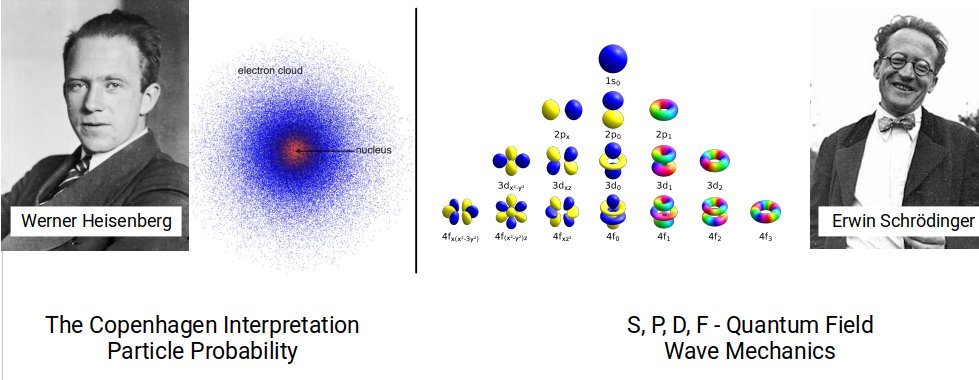
The outcome of this era of quantum physics were two clear contenders for the atomic model. The Copenhagen Interpretation, which is founded on the particle nature of light and electrons. And the Quantum Electrodynamics (QED) model that examines the atom from the perspective of a quantum field. Whilst QED does provide for solutions not predicted by the Copenhagen Interpretation, the mathematics of wave mechanics are quite heavy and cumbersome. As the particle model of the atom seems to be much easier to comprehend, it is more often used in explaining the simple concepts of the atom.
Geometric Model of the Universe
Geometry had inspired Erwin Schrödinger to develop his wave equations. It seems a shame that this idea was never pursued further. Throughout the presentation of the atom, the wave, and particle theory have tended to dismiss geometry. Yet, when we examine the representations of the S, P, D and F orbitals that arise from his wave equations, the relationship to geometry is quite astounding.
Through careful examination of the various orbital types and how they evolve, each can be ascribed a geometric shape. These are nested inside each other to express the different energy levels of the electron cloud. This new Atomic Geometry model can produce results that are far more accurate than the Copenhagen Interpretation, and dispenses the need for the electron as a particle. Instead, we find that the electron cloud is quantised by the geometry of the space surrounding the proton. The result is a 4D Geo-spatial model of the atom that can even be built from card.
The implications of this model are much further reaching than it first appears. The suggestion is that the geometry of a higher dimensional space is present in the space immediately surrounding a proton. When the proton receives more energy, it is emitted into the electron cloud. Once the energy exceeds a specific amount of energy, the cloud expands to the next geometry. Similar to a cup that, once enough water is poured into it, overflows. Similarly, the various orbitals are revealed by charging the hydrogen atom. At the various energy levels, the different orbital geometries reveal themselves. The quantisation of energy therefore has its root cause in the geometry of space itself. Whilst QED has produced some of the most accurate images of the electron cloud, this has also clearly demonstrated its geometric tendency.
One of the mysteries of the electron is that its mass is consistent, which gives the sense of a particle-like object. However, Atomic Geometry allows us to explain the nature of the electron cloud in terms of energy density, which remains consistent throughout the field. As the orbitals occupy more physical space, the energy density decreases proportionally. This quantises the energy levels of the atom into uniform units, described by the electrical charge constant (e). Therefore, all protons and electrons are the same throughout the Universe, denoted by a specific amount of energy.
What is a Particle?
Whilst the idea of a particle seems to be quite clear, upon closer examination it turns out that the distinction between matter-particles and matter-waves is not so obvious. The wave-particle duality model of matter suggests that it can act as both. But what is a particle?
In some respects, the particle represents a point in space, which is the way a scientific experiment takes its measurement. For example, a thermometer produces a reading based on its immediate surroundings. When the thermometer is moved to another location, a different reading is being registered from the new environment. Therefore, the simplest idea of a particle is found in the act of measurement.
The electron is a fundamental particle that cannot be divided. Yet, attempts to qualify its radius have eluded science even to this day. We find that from the perspective of QED, the electron is quantified in terms of its frequency. Therefore, the particle is considered a point of charge in space without a diameter.
Particles, like the proton and neutron, have defined mass values and charges. Other particles act as vectors, that exhibit little to no mass. The notion of mass is often associated with the weight of an object, but the definition is much broader. Mass makes up the total energy of a system. This also takes into account the particle’s motion in space. The faster the particle moves, the more energy is required. This is unified by the notion of the speed of light, with Einstein’s famous equation E = mc². A particle will be made of a certain amount of energy, which is contained within some kind of boundary.
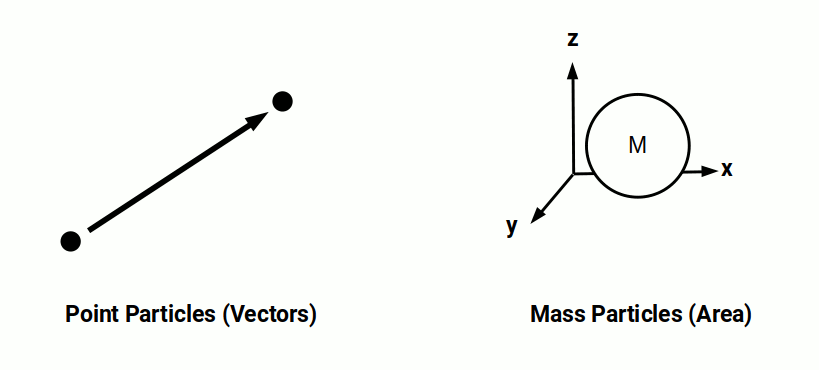
So, for a particle with mass, there is a boundary that divides the energy inside from the energy outside. But how is this boundary formed? When we examine the scientific literature, the concept of mass is defined in terms of matter. The definition of matter is similarly ambiguous. Explanations such as “anything that takes up space and can be weighed” do not clearly define this nature. In order for a substance to occupy space, it needs to exhibit a volume. 3D space is qualified with an x, y, and z axis. As particles, such as the proton, are spherical, it is logical to assume that its energy is being contained by the spherical geometry of space itself.
In 4D, the sphere can be represented as a 4D sphere or torus field, which in 3D will appear as 2 spheres in the same location. This 4D boundary can act as a container for the particle’s energy. The energy of an electron has a spin of 1/2. This means that for every 360° rotation in 3D space, the electron will need to rotate 720°. This is the quality of a 4D sphere, in a 2:1 ratio. Inside the atomic nucleus, protons are formed of quarks with a 1/3 and 2/3 quantum spin. This characterises the difference between energy within the boundary of the proton, and the immediate surroundings occupied by the electron cloud.
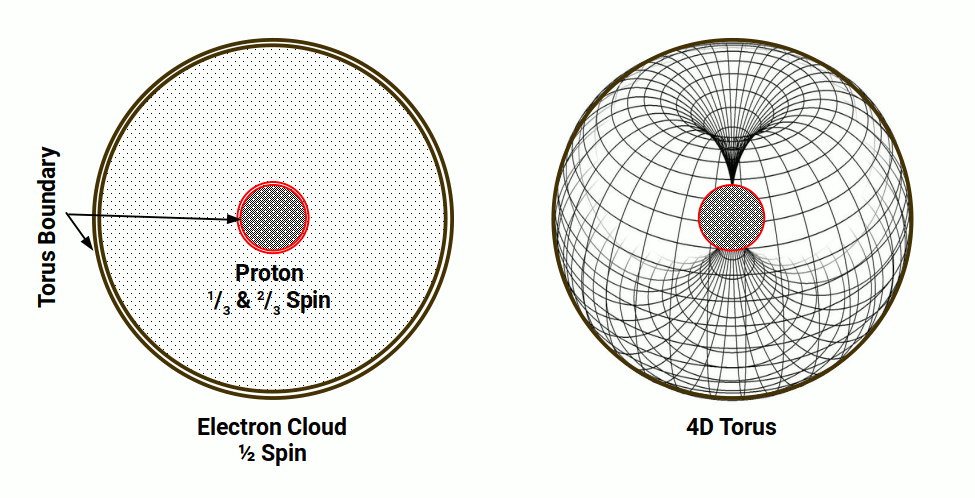
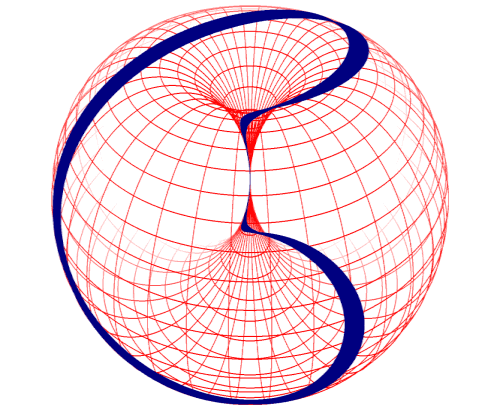
The animation of the line helps us to conceptualise the notion of 4D spin. The line passes twice over the surface of the sphere. This is similar to the electron cloud where electrons form pairs, termed UP or DOWN spin. Here, we can see that the same concept is translated in the 4th dimension. The torus acts like a standing spherical wave, which creates a boundary, a unit area of space. As there are exactly the same number of protons and electron, in the Universe, this view suggests that the cloud is not separate from the nucleus. They arise from the same 4D geometry, whose boundary is formed by the difference of the rotational ratio of 4D objects, compared to objects in 3D reality. The proton based on third spin charges, and the electron cloud of half spin are thus formed from energy, which, although exhibiting vastly different sizes, are equal in terms of charge. The electron field and the boundary that creates the proton are just aspects of the 4D nature of space.
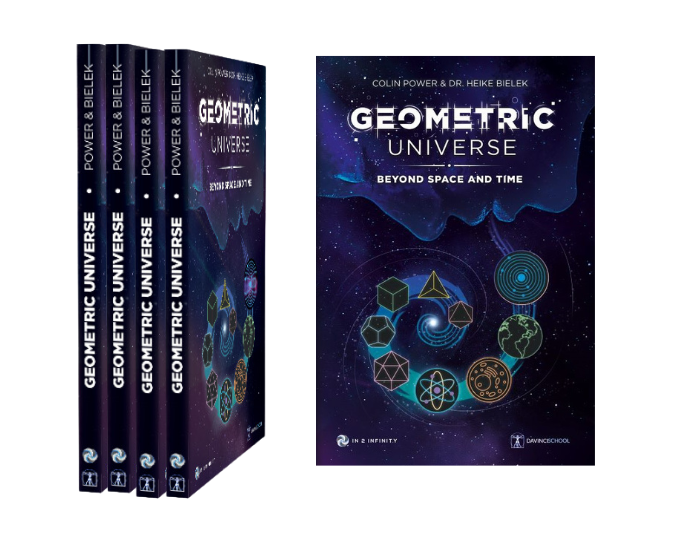
Book out now!
The Geometric Universe – Beyond space and time
This book unveils the Geometric Theory of the cosmos, from the atom to the galaxy. Filled with intricate illustrations, it offers a concise exploration of the Multidimensional Universe, challenging our understanding of space, time, and existence.
What is Mass?
As well as two types of particle, the vector, and sphere, there are also two main types of mass. These are differentiated by the velocity of an object. An object that is stationary sits in its rest mass, for which the equation E=mc² is founded. The second type of mass, is related to the amount of energy needed to accelerate an object through space. Light waves don’t exhibit a rest mass, but do exhibit a mass based on their momentum. Notice, that these two definitions of mass are applicable to the two different kinds of particle defined in the pervious section.
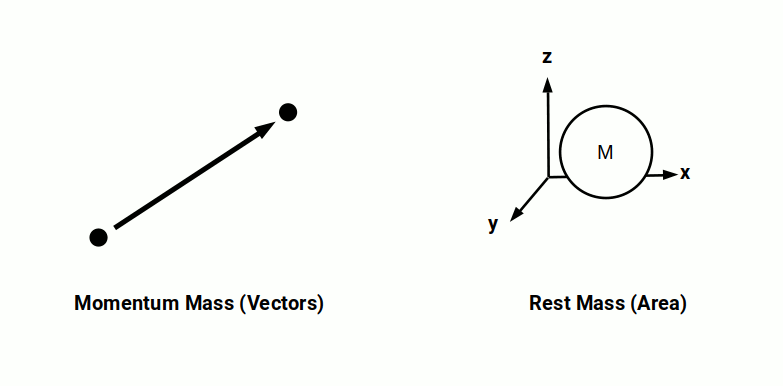
Massless particles such as the photon have no rest mass and are said to move at the speed of light through a vacuum. This speed is limited by the electromagnetic resistance of the vacuum, determined by two important scientific constants: the electrical resistance demoted by ε0 and the magnetic resistance denoted by μ0. It is from these constants the value for the speed of light and its relationship to energy (E) is founded. We explore this concept in more detail in our article that explores why the speed of light is constant.
In geometrical terms, when the energy is constrained within a boundary, such as the proton, or electron cloud, the object exhibits a rest mass. When the energy is free of this constraint, it emanates as a spherical wave across the vacuum of space. It is the resistance to the energy of the vacuum that determines the rate of expansion, which originates from the electron cloud, and in turn derives from its spin relationship to the proton. This concept begins to unify the nature of light with the electron cloud and the proton. Energy contained within the proton torus of 1/3 spin, produces a concentration of energy from the vacuum, which is in proportion to the energy of the electron. Atoms are continuously absorbing and emitting radiation, electromagnetic waves. When excited with more energy, the light that emits shifts towards ultraviolet in the visible spectrum of light – the object starts to glow. This is simply the displacement of the relationship of energy between the proton and the electron cloud, which overcomes the resistance of the vacuum and expands to infinity at the speed of light.
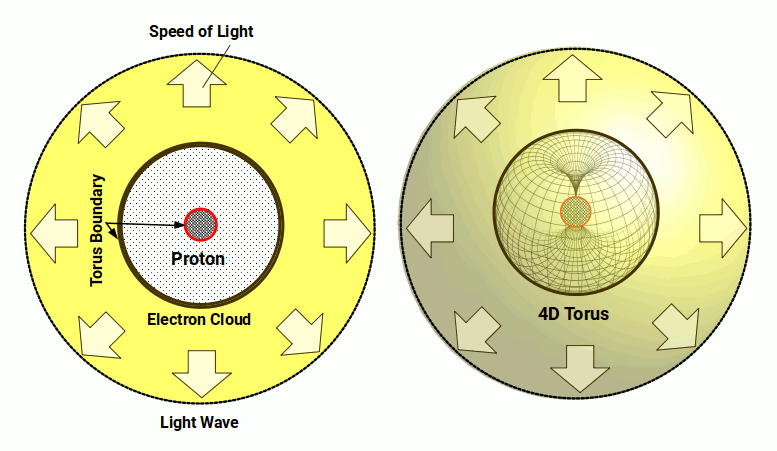
This perspective of mass considers the geometry of space as the key that determines the speed at which an object can move, or a wave can expand. And it also clearly defines the rest mass of particles that occupy an area of space. This is just a simple extension of the 4D model of matter. The space surrounding the electron cloud produces these spherical waves of light that expand across the vastness of space.
We also find there is evidence in support of this idea. Through the examination of the electrical field that surrounds an antenna, the near-field creates a double-layered torus, which contains (or amplifies) the electric field. The space beyond the torus is where the far-field begins, which is responsible for the transmission of the signal. The length of the transmitter determines the relative size of this torus field, whereas the amount of energy specifics the strength of the signal. This obeys the inverse square law that expresses the expansion of a spherical wave through space.
The energy of the vacuum has been described using a variety of different terms, including quantum fluctuations, energy density, and vacuum energy. Quantum Physics suggests it acts like a kind of foam formed of bizarre ‘virtual particles’, which seem to disobey the laws of physics. Yet, once we begin to examine its nature from the perspective of the 4th dimension, the reason for these strange anomalies starts to be revealed.
quantum foam
What is Energy?
The idea that energy can be directly translated into mass was one of the major discoveries of Albert Einstein. The equation E=mc² makes the direct correlation between units of energy (Joules) and mass (Kilograms). This idea was first postulated in Einstein’s seminal paper titled, “Does the inertia of a body depend upon its energy content?”. However, when Enistien first began to draw his conclusion, he expressly excludes the nature of the 4th dimension.

What this theory suggest is that the kinetic energy of an object moving in space is reduced due to the fact that it emits radiation of EM waves. This unifies the laws of motion and weight into the concept of energy. The ‘motion’ of the electron now adds to its overall energy value, which means it should collapse into the nucleus, one of the fundamental problems with the Bohr model of the atom. An object with mass will naturally slow down over time, until it resides in its rest mass. This gives an interesting relationship of the energy in the vacuum, and its resistance, which limits the speed of light. The reduction in the kinetic energy of the object is actually due to its movement through the medium that fills the space.
Einstein’s original notion was only considered from the perspective of 3D space. When we reintroduce the 4th dimension, the speed of light becomes limited by the 4D nature of space. In particular, the 4D rotation of the torus. A particle that receives energy is propelled through space. As it moves, it will lose some of that energy to the vacuum field, which radiates away from the atom as a spherical wave. The medium that carries this wave is a 4D quantum field. This is defined by particle spin values, which is why energy quanta take on a different perspective. Instead of dissipating through space, we find that it now forms the function of driving the rotation of a 4D object. An object is accelerated when energy is added to it, which increases its rate of 4D spin. Thus, the particle is moved out of energetic balance from its rest mass. It will begin to emit light at a certain rate, which is limited by the speed of light (c). This excess radiation is carried through the medium of the 4D quantum field (Aether). And it appears as a set of nested shells, whose spacing determines the wavelength and frequency, of that particular EM wave.
The 1st animated image above shows the rotation of a torus nested in a torus field. The second image portrays a whole set of torus fields, that expand to ever larger sizes. This toroidal structure limits the speed of light, and can produce different wavelengths by setting the ratio between each shell to a specific value.
This 4D model of EM waves and its relationship to mass is not considered by the traditional mass-energy equation. What we find is, that it is the original incarnation of the energy-mass equation, expressed in the notion of the inverse square law: the intensity of light diminishes as it expands through space. This is expressed as the inverse of the square of the distance travelled. As the radius of the sphere increases, the surface area also gets bigger. The equation that derives the surface area is r² x4π. The magnetic resistance of the vacuum has a value of 4π, which an electromagnetic wave must overcome in order to propagate through space. The speed of light squared is equal to the energy per unit of mass that is emitted into the vacuum. We can therefore recognise a direct relationship to this notion and the intensity of light.
A sphere, with a radius of 1, will also have 1 as its square. A sphere, with the radius 3, will have 9 as the square of its radius. By setting the speed of light to 300,000,000 metres per second, each gram of mass will have an energy value of 90,000,000,000,000 Joules. This concept sees the intensity of light as being distributed over the surface of the spherical electromagnetic wave. As the wavefront propagates through the vacuum, it diminishes in intensity as it expands.
Why is the speed of light constant?
Gravity and the Aether
The Aether is the original name given for the medium that could transport light through the vacuum. It was abandoned as the concepts of the photon as a particle of light was presumed to be able to travel through a vacuum. However, quantum field mechanics have readopted the idea, albeit under a different guise. Yet, the term Aether has remained a taboo for most mainstream scientists. With the discoveries of a Cosmic Microwave Background (CMB) in 1964, the fact has arisen that the whole Universe is immersed in an almost uniform field of energy. Whether we use the idea of a quantum field at the microscopic level, The Cosmic Microwave Background, or the Aether, does not change this fact. It is unfortunate that science has chosen to view the CMB as the remanent of the Big Bang. As we have suggested, the very nature of particles with a rest mass is due to the spherical boundary of a 4D torus, that is created by the difference of 4D quantum spin. But where does this energy come from in the first place?
The energy volume of the proton and electron cloud are very specific, as both are exactly in the same proportion. This uniformity of energy is denoted in integer units by the electrical charge constant, (e). Yet, the size of the proton, is minuscule compared to the volume of space occupied by the electron cloud. A single proton has a radius of around 0.84-0.87 femtometres across, and contains over 99% of the mass of the atom. This can be brought into logical perspective, when we take into account the energy of the vacuum, or the 4D Aether.
In the 4D Aether theory, protons and neutrons are created by torus shells, which act as resonant chambers, similar to those that are used in lasers to amplify light. This is driven by the principles of geometry, which explains the simple nature of quantum spin. A light wave must travel through 2 half cycles to complete one wavelength, similar to the electron that is assigned a quantum spin value of ½. Protons are made of quarks that have ⅓ and ⅔ spin. When we divide the proton spin by the electron spin, the value is spectacularly close to gravitational constant (G).
(1/3 Proton spin) ÷ (1/2 electron spin) = 2/3 ≈ Gravitational Constant (G)
The unification of quantum spin numbers and the notion of gravity is one of the largest problems facing science today. Yet, the 4D nature of spin begins to shed new light into this puzzling phenomena. When we consider the original gravitational equation proposed by Newton, we find a surprising similarity to the inverse square law of the intensity of light.
The gravitational constant is found by the addition of the masses of two bodies, divided by the square of the distance. The proportion of the masses is therefore irrelevant, as only their combined masses factor into the equation. The gravitational constant acts in accordance with the expansion of a spherical wave. However, instead of the electromagnetic waves, based on the rotation of 1/2 spin, gravitational waves are formed from the interaction of the 1/3 spin of the proton, and the 1/2 of the electron.
If we reverse the equation, so that the rotation of the electron spin is divided by the proton spin, the result is 3/2. The number 3 can be seen as the speed of light, which when divided into two creates an electromagnetic wave with a wavelength of around 150 nm. In our solution to the photoelectric effect, we show how the work function of a material multiplied by the threshold wavelength, when squared, will equal half the speed of light.
Therefore, we can see that gravity is the force that contains the energy of the proton, through its relationship of the electron’s quantum spin. The energy that is extracted from the vacuum can be explained by the relationship of the electron spin to the proton.

In dimensionless science, we ascribe the value ⅔ to the gravitational constant and a ratio of light (3) to space (2). The speed of light is ascribed the value of 3, and the concept of space is the midpoint between the distance of measurement.
Unified Field theory
Whilst the notion of a quantum field is well understood, its failings have been with its capacity to explain the nature of gravity. This elusive force has been measured empirical, however, the theory of relativity has substituted Newton’s original concept. Yet, the fundamental mechanic of gravity have never been resolved. Even today, no theory exists that can explain the nature of gravity at the galactic scale.
An electromagnet is created by wrapping a wire in concentric circles. The same can be said of an electrical generator that passes a magnet through a coil of wire. It is the geometry of the wire that creates the effect. Therefore, the geometric idea of the force of gravity and electromagnetism seem to be intimately related.
It is a miraculous fact that there are the same number of protons as there are electrons in the Universe. This equality in number suggest that their existence has a deep unified cause. Therefore, we can consider the total number of protons and electrons represented on the circumference of a circle divided into two. One half for the electrons with 1/2 spin and the other for the proton with 1/3 spin. We can divide each half circle into two and three parts, respectively. Each electron now occupies a value of ¼π, depending upon whether it has an up or down quantum spin number. Notice, that this is the reciprocal value of the magnetic resistance constant (μ0) found in the vacuum. The other half circle represents protons that are made of quarks with 1/3 and 2/3 charges. This is divided in three, and now each section will measure 1/6π. When multiplied by 1/6 the result is the electrical resistance constant (ε0).
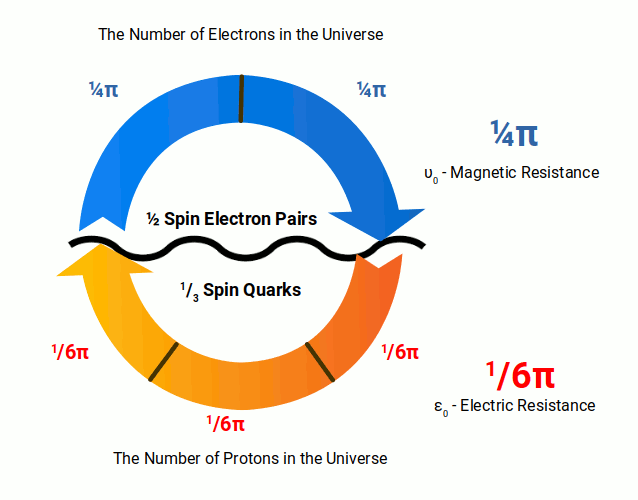
The line that divides the circle can be considered as the boundary between the proton and electron cloud. This begins to redefine our notion of the particle. The 1/2 quantum spin number of the electron is now ascribed to the magnetic resistance of the vacuum energy. The 1/6 spin of the proton is multiplied by 6 to complete a full circle. This is then divided by the 1/4 quantum spin value of the electron to produce the gravitational constant. The relationship between magnetism and gravity is therefore easily explained.
(6ε0) ÷ (1/μ0) ≈ G ×10-6
(6 × 1/36π) ÷ (1/4π) = 2/3
A similar process can be seen in the nature of the electrons. The energy electrical circuit does not run down the wire, as it is commonly believed. The energy is drawn from the vacuum of space, based on overcoming the magnetic resistance μ0. When the 1/4π value for the electron is divided by the 1/6π spin of the proton, the result produces the wavelength of light that solves the photoelectric effect: the work function constant. This value happens to be the point of harmonic resonance that can extract energy from the vacuum, which offers a new explanation of the solar cell.
(1/μ0) ÷ (6ε0) ≈ c/2
(1/4π) ÷ (6 × 1/36π) = 3/2
This makes a clear distinction between the E and B field of the electromagnetic wave as two different aspects of spin. Each of these two fields can now be expressed on different types of 2D plane. In geometry, there are only two regular shapes that can fill an infinite space using only two colours. The triangle and the square. Triangles join together to form a hexagonal tapestry, that can fill a 2D plane with three colours. This divides the circle into six and four, in exactly the same ratios as the electrical and magnetic resistance constants.
This offers the first explanation as to the origin of charged particles, which now arises through the ratio of different energy derived from two types of 2D plane. We also find that the structure of the visible light spectrum is also composed of the same ratios. Our new theory of Geo-optics suggests that the different frequencies of colour arise from the mixing of two types of colour wave, the red-green-red, and the yellow-blue. This nature of light can provide a wave-based solution to the photoelectric effect, which provides an alternative to the idea of the photon particle of light.
We have finally arrived at a model that can begin to unify all the forces that govern the Universe into a single circle. From light, gravitation, and charge, the interplay now resolves their interaction based on geometry.
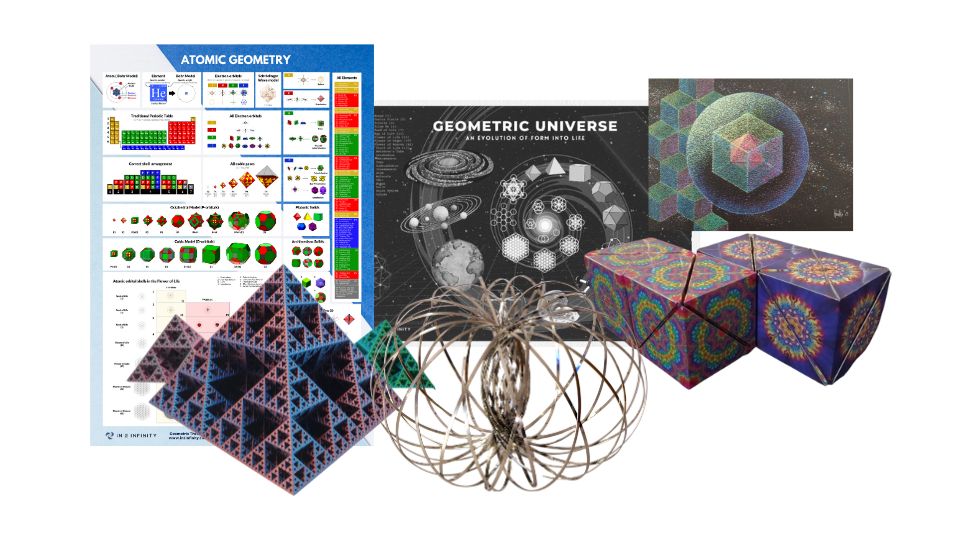
Online Shop
Grab your geometric goodies!
Discover a wealth of inspiration at our online shop! From visually stunning educational posters to captivating geometric mind games and original art, immerse yourself in a collection designed to unravel the mysteries of the Geometric Universe.
The Geometric Universe
One of the key differences between the present theory of quantum physics and the 4D geometric concept is the notion of the Aether. Whilst quantum science alludes to the existence of a quantum field, it does not make a clear link between the Cosmic Microwave background, and the nature of Quantum Foam. The 4D Aether theory describes the quantum field in terms of 4D geometry, and as such, suggests that this medium allows for the propagation of light waves. This disposes the idea of a photon of light, and removes much of the quantum weirdness found with the particle model.
There are repercussions of the 4D view, as the nature of the CMB is now no longer associated with the theory of the Big Bang. This brings into question the traditional scientific notion of the beginnings of the Universe. According to present theory, the Observable Universe has a diameter of around 93 billion light years, which is around 0.44 x101024 km. This distance is limited by the nature of the speed of light, and the predicted age of the Universe, not by our ability to build better measuring equipment. This sphere has a boundary through which light cannot pass.
From the Earth, the Observable Universe is predicted to extend 46.5 billion Light Years.
Regardless of the actual age of the Universe, it may be contained in a certain size. The energy of the Cosmic Microwave Background is also extremely flat. If a certain amount of protons and electron came from this field, we might assume that the Universe itself is in a state of equilibrium. Just as the proton exhibits a boundary that contains quarks, could there be a limit to the Universe itself?
The radius of the present predictions of the size of the Universe creates a sphere with a radius of 0.44 x101024. By using the value 0.44 we can divide by the speed of light (c) to produce a second sphere that now has a relative smaller radius of 14.67×10-9 Km. When we subtract Newtons gravitational constant (G), the result reduces further to 14.009×10-9 Km, close to the whole number 14. As the initial radius of the observable universe was 0.44, when we divide by the radius of the smaller circle, the result is very close to π×10-8. This means there is an interesting geometric relationship between the predicted size of the observable universe, the speed of light, and gravity.
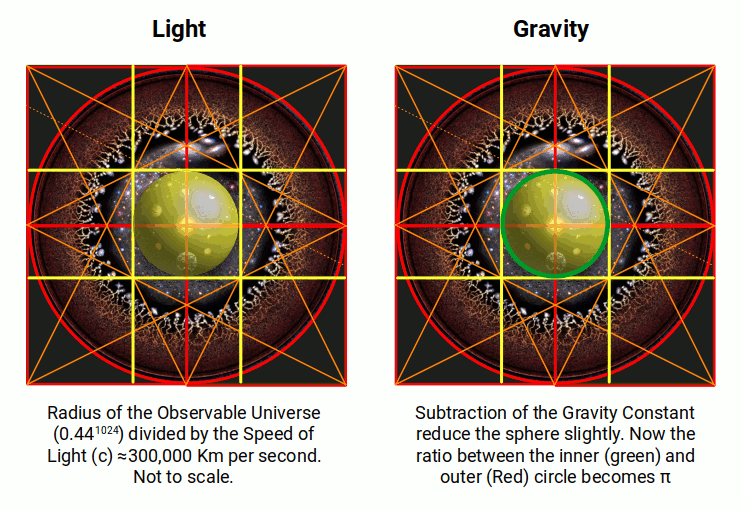
The above image shows the Observable Universe encapsulated in a circle. The inner yellow sphere represents the size of the Universe divided by the speed of light. The green rim represents the boundary that forms when the sphere is reduced in size by the gravity constant. At this point, the relationship between the inner sphere and the observable universe becomes π. The orange lines extend from the corners of the surrounding square to the midpoint of the opposing side. This is called the sand reckoner diagram, which is a geometric technique for dividing the surface area of a square into equal proportions. This generates squares of 2,3,4,5, 7 and 11. As 11/7 is a rough estimation of ½π, it can also be used to create a close approximation to a circle whose circumference is the length of the square’s sides.
This might all be wild conjecture, as we have no real way of knowing how big or old the actual universe is, other than through computer simulations based on the expansion rate of the Universe. This is presently a topic of hot debate, termed the ‘Cosmological Crisis‘.
However, the nature of universal coincidences at large number scales has often been considered by some of the greatest scientific minds. The ‘Large Numbers Hypothesis (LNH), proposed in 1937 by Paul Dirac, a highly influential figure in the development of quantum theory, held various mathematical observations about the Universe. It was noted that the gravitational constant (G) seemed to be inversely proportional to the age of the Universe. Even the mass of the Universe seemed to be in proportion to the square of its age.
Ideas such as these were heavily influenced by Author Eddington, who tried to calculate the number of protons in the Universe. Rather than today’s methods that try to guess the number by observing the masses of galaxies in local space, his approach was based on the fine structure constant (α). This interesting scientific constant is found throughout the equations that govern the structure of the Universe. Yet, its appearance is still a mystery to scientists today. Eddington’s speculation was found by raising the inverse of the fine structure (α), a value close to 137, by a power of 256.
α × 2256 = 1.58,676 846,249,327,73 e +79
(α × 2256 × 2) ÷ π× 1079 = 1.0101 ≈ 1
It is interesting to note that this value is very close to ½π. Previously, we used the same number to represent the proton and electron spins that create the electrical and magnetic resistance values that are found to be consistent throughout the Universe. Author Eddington’s association of the fine structure constant to the number of protons was somewhat dismissed by most scientists. However, there does appear to be a correlation between this mysterious constant, the electrical charge of the proton/electron, and the size of the Universe.
In Dimensionless Science, the electrical charge constant (e) is also ascribed the value of ½π. This is directly related to a single unit of energy (E) by the energy of a photon (Ep). This gives the photon energy a value of 2÷π, which is the relationship of energy to the charge of the electron. Therefore, this relationship is simply the expression of the circumference of a circle to a radius of 1. The point of transformation between the line and the circle is a mathematical enigma that seems to defy definition, but is easily expressed using a simple drawing compass.
This model of matter presents points towards a unifying theory based on the nature of geometry and numbers, similar to the ancient Pythagorean notion of the monad, which considers the numerical foundations of the Universe. It is also compatible with aspects of the atomist view. The definition of the particle can be applied to the boundary of the light at the edge of the Universe, thus unifying the macro and micro cosmic domains. Once we begin to observe and study the universe through the lens of geometry, the relationships, and reason for the appearance of the most fundamental forces of nature can be revealed.
THE
Conclusion
What is the 4D wave Model of Matter?
This model arises out of the belief that the CMB, Quantum Foam, and Quantum Field are all names describing the 4D nature of space. The 4D Aether creates the particle boundaries of the proton and electron cloud. This now identifies the electrical and magnetic components of the EM field as being derived from the nature of quantum spin. The 1/2 spin of the electron and 1/3 spin of the quark are key in determining the relationship between gravitational and electrical phenomena. The idea of a particle is resolved as a boundary between these different quantised states of the electron and proton, which forms the energy density that maintains a state of equilibrium. Any excess energy, not part of the rest mass, will be radiated out through the cosmos as an EM wave.
A New vision of reality?
The idea that matter is a wave has already been established. However, what has never been clarified are the exact scientific definitions of terms like mass and matter. The theory of the 4D wave model of matter offers a concise definition of matter and outlines the reason for the nature of charge. This allows us to more clearly define these important characteristics of nature, and unify the laws of electromagnetism with the laws of gravitation, and the atom.
Part 1: Wave model of Light
Carry On Learning
This article is part of our new theory on the 4D AETHER. Browse more interesting post from the list below.


Can the photoelectric effect be explained without the need for a photon?
The concept of the photon is based on our present solution to the photoelectric effect. However, this solution cannot be true, as the speed at which electrons are released into the circuit is much faster than the interactions between a photon and an electron. Our new 4D solution shows that it is the geometry of light and space that are actually responsible for this effect, ushering in a new theory of energy generation, extracted from the vacuum of space.
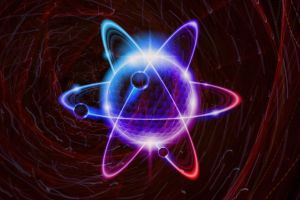
The 4D Electron Cloud
The electron cloud is normally thought about in terms of the probability of the particle. However, our notion of a 4D Aether dispenses with this notion, returning a sense of normally to atomic physics.

Is there an alternative to wave particle duality?
Central to quantum physics is the notion of wave particle duality. However, the concept of a photon particle of light is not needed if the Aether that can transmit the wave through the vacuum can be established. By adopting a 4D view, we are able to achieve this, which is set to revolutionise our view of the universe, from the atom, to electrical generation.
YOUR QUESTIONS ANSWERED
Got a Question? Then leave a comment below.

Question?
Does this mean that the universe is not expanding?
ANSWER?
The 4D Aether theory does not explicitly prohibit the Expanding Universe Theory, however, it seriously challenges the framework of thinking around the issue. We identify the Cosmic Microwave Background as the source of the energy, that forms a certain number of protons. These are the same number as the electrons in the Universe, with each exhibiting a single unit of electrical charge. This and the uniformity of the CMB suggests that a state of equilibrium is reached, whereby the force of gravity defines the boundary of the proton. This interpretation of quantum spin radically alters concepts such as the strong force in the nucleus. Now, the binding agent becomes a property of a 4D spin ratio.

Question?
How does the number 1.5 mean that energy is being extracted from the vacuum?
ANSWER?
In our solution to the photoelectric effect, we see that the energy created in the circuit by the ultraviolet light is not contained within the light itself. Moreover, the wavelength of light creates a resonance in the material at a specific frequency. This triggers a release of energy at the surface boundary of the material, drawing energy from the vacuum. Different materials produce energies at different frequencies of light which is relative to the material, and the wavelength of light. When these two values are multiplied together and squared, the result is always around 150 nm. or half the speed of light.

